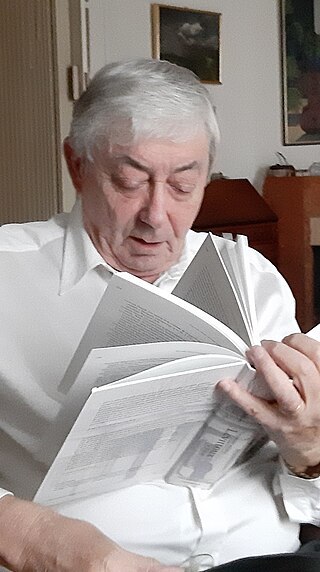
Kip Stephen Thorne is an American theoretical physicist and writer known for his contributions in gravitational physics and astrophysics. Along with Rainer Weiss and Barry C. Barish, he was awarded the 2017 Nobel Prize in Physics for his contributions to the LIGO detector and the observation of gravitational waves.

São José dos Campos is a major city and the seat of the municipality of the same name in the state of São Paulo, Brazil. One of the leading industrial and research centers with emphasis in aerospace sciences in Latin America, the city is located in the Paraíba Valley, between the two most active production and consumption regions in the country; São Paulo and Rio de Janeiro. It is the main city of the Metropolitan Region of Vale do Paraíba e Litoral Norte. A native of São José dos Campos is called a joseense. Being the second most populous non-capital city in Brazil – behind Campinas – São José dos Campos lies in the middle of the Expanded Metropolitan Complex, the first megalopolis in the Southern Hemisphere, with over thirty million inhabitants. The city's metro area also includes Greater São Paulo, Campinas, Santos and Sorocaba. The municipality concentrates many major companies and industries, such as Embraer, Panasonic, Johnson & Johnson, Ericsson, Philips, General Motors, Petrobras, Monsanto among others. São José dos Campos also holds relevant education and research institutions, as ITA, INPE, CEMADEN, IEAv, IEA, IFI, UNESP, UNIFESP, DCTA, FATEC, UNIVAP and IP%D, holding a position the puts the city as the main and largest Aerospacial Complex in Latin America. Thus, it is also considered the warlike producer centre. The Technological Park, the largest one in the country, is the only research institute in the world that converges all the three top global plane production companies, Embraer, Boeing and Airbus.

The Paraíba Valley is a landform that encompasses the regions: Paraíba Valley Metropolitan Region and Northern Coast, in the state of São Paulo and Sul-Fluminense Region, in the state of Rio de Janeiro, which stands out for concentrating a considerable portion of the Brazilian economy.

Science and technology in Brazil has entered the international arena in recent decades. The central agency for science and technology in Brazil is the Ministry of Science and Technology, which includes the CNPq and Finep. This ministry also has a direct supervision over the National Institute for Space Research, the National Institute of Amazonian Research, and the National Institute of Technology (Brazil). The ministry is also responsible for the Secretariat for Computer and Automation Policy, which is the successor of the SEI. The Ministry of Science and Technology, which the Sarney government created in March 1985, was headed initially by a person associated with the nationalist ideologies of the past. Although the new minister was able to raise the budget for the science and technology sector, he remained isolated within the government and had no influence on policy making for the economy.
José Leite Lopes was a Brazilian theoretical physicist who worked in the field of quantum field theory and particle physics.

The Max Planck Institute for Gravitational Physics is a Max Planck Institute whose research is aimed at investigating Einstein's theory of relativity and beyond: Mathematics, quantum gravity, astrophysical relativity, and gravitational-wave astronomy. The institute was founded in 1995 and is located in the Potsdam Science Park in Golm, Potsdam and in Hannover where it closely collaborates with the Leibniz University Hannover. Both the Potsdam and the Hannover parts of the institute are organized in three research departments and host a number of independent research groups.

The Instituto Tecnológico de Aeronáutica is an institution of higher education maintained by the Brazilian Air Force and is located in São José dos Campos, Brazil. ITA is consistently ranked as one of the top engineering schools in Brazil and engages in advanced research in aerospace science and technology.

The Brazilian Department of Science and Aerospace Technology is the national military research center for aviation and space flight. It is subordinated to the Brazilian Air Force (FAB).

São Paulo State University is a public university run by the state government of São Paulo, Brazil.

The National Civil Aviation Agency, is the Brazilian civil aviation authority, created in 2005. It is headquartered in the Edifício Parque Cidade Corporate in Brasília. A part of the Brazilian Secretariat of Civil Aviation, the agency raised from the former Department of Civil Aviation (DAC) and the Civil Aviation Certification Division, the Brazilian aircraft certification authority. ANAC is responsible for regulating and overseeing civil aviation activities, aeronautics and aerodromes infrastructure.

Remo Ruffini is an Italian astrophysicist. He is the Director of ICRANet, International Centre for Relativistic Astrophysics Network and one of the founders of the International Centre for Relativistic Astrophysics (ICRA). Ruffini initiated the International Relativistic Astrophysics PhD, a common graduate school program of several universities and research institutes for the education of theoretical astrophysicists. He is the Director of the Erasmus Mundus IRAP PhD program. He has been Professor of Theoretical Physics at the University of Rome "Sapienza" from 1978 to 2012.

ICRANet, the International Center for Relativistic Astrophysics Network, is an international organization which promotes research activities in relativistic astrophysics and related areas. Its members are four countries and three Universities and Research Centers: Armenia, the Federative Republic of Brazil, Italian Republic, the Vatican City State, the University of Arizona (USA), Stanford University (USA) and ICRA.
Waldyr Alves Rodrigues, Jr. born at Araraquara, SP, Brazil, obtained his B.Sc. in physics in 1968 at the University of São Paulo (Brazil), where he has been a research student of Mário Schenberg and became an assistant professor in 1969. He then moved to Torino, Italy, where he did postgraduate studies at the Scuola di Perfezionamento in Fisica Nucleare and obtained a degree in theoretical nuclear physics in 1971. Later that year, he returned to Brazil and became an associate professor at the new Physics Institute of Campinas State University (UNICAMP).

The Federal Institute of São Paulo, or in full: Federal Institute of Education, Science and Technology of São Paulo is an institution that offers high education and professional education by having a pluricurricular form. It is a multicampi institution, specializing in offering professional and technological education in different areas of knowledge. It was known previously as Federal Center of Technological Education of São Paulo. IFSP is one of the five Federal Colleges in São Paulo, the other ones being ITA, UFSCar, UNIFESP and UFABC.

Vladimir Alekseevich Belinski is a Russian and Italian theoretical physicist involved in research in cosmology and general relativity. He worked at Landau Institute for Theoretical Physics from 1968 to 1989 and got his Habilitation degree at this Institute in 1980. As of 2016, he holds the permanent professor position at International Network of the Centers for Relativistic Astrophysics (ICRANet), Italy.
The Mario Schenberg is a spherical, resonant-mass, gravitational wave detector formerly run by the Physics Institute of the University of São Paulo, named after Mário Schenberg. Similar to the Dutch-run MiniGrail, the 1.15 ton, 65 cm diameter spherical test mass is suspended in a cryogenic vacuum enclosure, kept at 20 mK; and the sensors (transducers) for this detector/antenna are developed at the National Institute for Space Research (INPE), in Sao José dos Campos, Brazil. As of 2016, the antenna has not detected any gravitational waves, and development of the antenna continues. It has been decided that the antenna will be transferred from the University of São Paulo to INPE.

Anatoly Alekseyevich Logunov was a Soviet and Russian theoretical physicist, academician of the USSR Academy of Sciences and Russian Academy of Sciences. He was awarded the Bogolyubov Prize in 1996.
Moshe Carmeli was the Albert Einstein Professor of Theoretical Physics, Ben Gurion University (BGU), Beer Sheva, Israel and President of the Israel Physical Society. He received his D.Sc. from the Technion-Israel Institute of Technology in 1964. He became the first full professor at BGU's new Department of Physics. He did significant theoretical work in the fields of cosmology, astrophysics, general and special relativity, gauge theory, and mathematical physics, authoring 4 books, co-authoring 4 others, and publishing 128 refereed research papers in various journals and forums, plus assorted other publications. He is most notable for his work on gauge theory and his development of the theory of cosmological general relativity, which extends Albert Einstein's theory of general relativity from a four-dimensional spacetime to a five-dimensional space-velocity framework.
ICRA, the International Center for Relativistic Astrophysics is an international research institute for relativistic astrophysics and related areas. Its members are seven Universities and four organizations. The center is located in Rome, Italy.

Richard Kerner is a French theoretical physicist andProfessor Emeritus of Pierre and Marie Curie University whose research extends into gravitation, cosmology, field theory, solid-state physics, noncommutative geometry, quantum mechanics and mathematical and theoretical biology.















